
ER5183 Aluminum-Magnesium Alloy Welding Wire
As an aluminum-magnesium alloy welding wire, the mechanical properties of ER5183 are primarily determined by its chemical composition and processing state. The following is a comprehensive analysis based on industry standards, manufacturer data, and research literature:
I. Basic Mechanical Properties
Ultimate Tensile Strength (UTS)
Welding wire itself: The typical value ranges from 275 MPa to 300 MPa. According to some manufacturers' data, the as-welded deposited metal can reach 280 MPa to 296 MPa. For example, the UTS of ER5183 listed in Jingqun Welding Materials' data sheet is 296 MPa, with a yield strength of 145 MPa and an elongation of 16%.
Welded joints: Affected by base metal dilution and welding processes, the joint strength is usually 80%-90% of the welding wire itself. For instance, when ER5183 is used to weld 6061 aluminum alloy, the tensile strength of the joint can reach 226.76 MPa (70% of the base metal strength).
Yield Strength (YS)
The yield strength of the welding wire itself ranges from 125 MPa to 140 MPa, while the as-welded deposited metal can reach around 150 MPa. This property ensures good deformation resistance after welding.
Elongation
The elongation of the welding wire itself is typically 15%-20%, and that of the as-welded deposited metal is 16%-18%. For example, the elongation of ER5183 deposited metal from Sinoalweld is 18%, indicating excellent toughness.
II. Key Influencing Factors
Chemical Composition and Strengthening Mechanism
ER5183 contains 4.3%-5.2% Mg and 0.5%-1.0% Mn. Magnesium enhances strength through solid solution strengthening, while manganese refines grains and improves corrosion resistance. This composition design gives ER5183 a significantly higher tensile strength than ER5356 (typical UTS: 250-300 MPa).
Hydrogen content control: The hydrogen content in the welding wire must be below 0.18 μg/g; otherwise, it may lead to reduced weld strength and increased crack sensitivity.
Heat Treatment State
ER5183 is usually supplied in annealed state (O) or cold-worked hardened state (e.g., H111, H321). Cold working can improve strength but reduces elongation. For example, the base metal of 5083 aluminum alloy in H321 state can reach a tensile strength of 317 MPa, but specific cold-work state data for the welding wire remains unclear.
Welding Processes and Application Scenarios
Shielding gas: Pure argon or argon-helium mixture is recommended to avoid oxidation and porosity defects.
High-temperature limitation: ER5183 is not recommended for continuous high-temperature environments (>66℃), as its stress corrosion resistance decreases.
Low-temperature performance: It maintains excellent toughness at -196℃, making it suitable for low-temperature scenarios such as liquefied natural gas (LNG) storage tanks.
III. Comparison with ER5356
| Property | ER5183 | ER5356 |
|---|---|---|
| Ultimate Tensile Strength | 275-300 MPa | 250-300 MPa |
| Yield Strength | 125-140 MPa | 110-140 MPa |
| Elongation | 15%-20% | 15%-25% |
| Corrosion Resistance | Excellent (especially seawater corrosion resistance) | Good (general-purpose) |
| Typical Applications | Marine engineering, pressure vessels, nuclear facilities | General structures, automotive components |
IV. Industry Standards and Certifications
AWS A5.10: ER5183 must meet the minimum requirement of UTS ≥ 275 MPa.
GB/T 10858: Its chemical composition is consistent with AWS standards, but mechanical properties are not clearly classified and depend on manufacturer data.
Certifications: Common certifications include ABS (American Bureau of Shipping) and CE, which are applicable to marine and pressure vessel manufacturing.
V. Typical Application Scenarios
Marine Engineering: Used for welding 5083 aluminum alloy ship plates, with a tensile strength meeting the requirement of over 276 MPa and excellent seawater corrosion resistance.
Low-Temperature Vessels: Maintains high toughness at -196℃, suitable for welding LNG storage tanks and pipelines.
Nuclear Industry & Pressure Vessels: Its high strength and corrosion resistance make it applicable to nuclear facilities and chemical equipment.
VI. Precautions
Welding parameters: The current range for MIG welding is 180-450 A, and for TIG welding is 150-400 A, which should be adjusted according to the base metal thickness.
Surface treatment: Oils, greases, and oxide films must be thoroughly removed before welding to avoid porosity and cracks.
Heat input control: Low-heat processes such as double-pulse MIG welding are recommended to reduce softening in the heat-affected zone (HAZ).
Summary
ER5183 is a preferred welding wire for aluminum-magnesium alloy welding, thanks to its high strength (UTS: 275-300 MPa), good toughness (elongation: 15%-20%), and excellent corrosion resistance. Its performance is comprehensively influenced by chemical composition, heat treatment state, and welding processes. In practical applications, the appropriate state and parameters should be selected based on specific scenarios: for example, H111 or H321 state is preferred in shipbuilding to improve strength, while annealed state is emphasized for toughness in low-temperature vessels. By controlling hydrogen content and optimizing welding processes, ER5183 can ensure joint strength while reducing crack risks, meeting the needs of high-end industrial applications.
Hot Tags: er5183 aluminum-magnesium alloy welding wire, China, manufacturers, suppliers, factory, company, wholesale, discount, buy, low price, high quality, products
You Might Also Like
Send Inquiry










